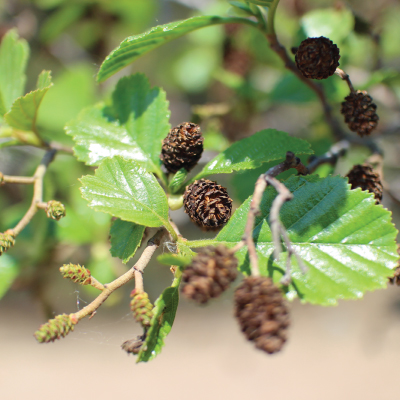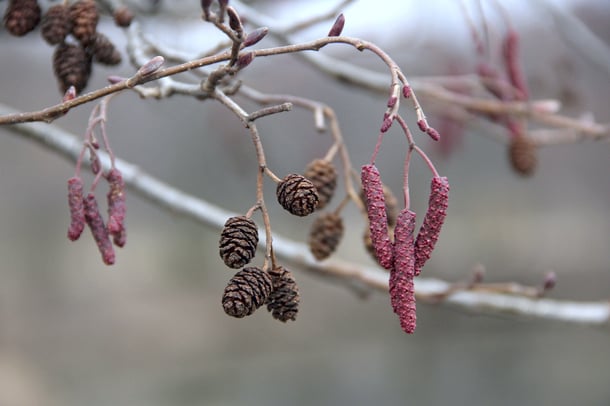
Stands of aspen fluttering in the wind and thick conifer trees create breathtaking views for all to enjoy. Although many visitors may easily recognize these charismatic trees, many other trees call Colorado and Eagle Valley home. One such tree is the alder, a medium-height deciduous tree with gray bark. Alders can be identified by their egg-shaped serrated leaves with distinct veins. They can grow with a single silvery-gray trunk or sometimes grow with multiple stems and take on a shrubby appearance. Although cones are typically associated with coniferous or evergreen trees, this unique broad-leaf deciduous tree also grows cone-like structures, called strobiles, to hold its seeds. While there are many species of alder, the thinleaf alder calls the Rocky Mountains home. They are commonly found in riparian zones, along the sides of streams and other waterways, alongside willows, red-osier dogwood, and wild rose. In addition, they tend to occur at a higher elevation than the narrow-leaf cottonwood. Although alders are deciduous trees they will not contribute to the beautiful display of colors that fall brings since their leaves drop when they are still green.
Even though these trees may seem ordinary at first glance, they provide many important benefits for our local ecosystem. Unlike many trees that are unable to survive in oxygen-depleted standing water, alders thrive in swampy areas and are commonly found near ponds and streams along with other water-loving plants. These riparian areas attract many water-loving animals including beavers. Alders are an important link in the food chain for beavers who can rely on these trees as a staple in their diet as well as material for their dams. The wetlands that are created by beaver dams kill off many tree species that do not like having wet roots but do not deter alders which are adapted to large areas of standing water.

Beavers are not the only organism that has a relationship with the alder. Alders have a symbiotic relationship with bacteria as well which provides benefits for the entire ecosystem. Along will all other alder species, the thinleaf alder releases nitrogen into the soil through nodules on its roots. Nitrogen is an essential nutrient for plant life but is useless unless it is broken down by bacteria. Having this relationship allows the alder to not only get the nutrients it needs to survive but replenishes the soil with nitrogen to the benefit of other plant life.
Alders provide yet another ecosystem service through erosion prevention and restoration. Erosion from storms, flooding and human disturbance leads to the loss of soil and consequently nitrogen. The alder’s ability to hold riverbanks in place and return nitrogen to the soil has been capitalized on through the use of alders as a cover crop to help manage erosion and improve soil quality.
While sometimes unnoticed on hikes along the creek, alders provide many benefits for the ecosystem around them. Try to spot one of Eagle County’s many alders on your next trip outdoors and who knows, you might also run into a beaver along the way!
Dominique Rosario is a Naturalist at Walking Mountains Science Center and loves hiking and learning more about the trees that surround her.
Sources:
The hidden life of trees (book)
https://www.fs.fed.us/database/feis/plants/tree/alninc/all.html
https://www.trailkeepersoforegon.org/the-alder-tree-of-earth-fire-and-water/









